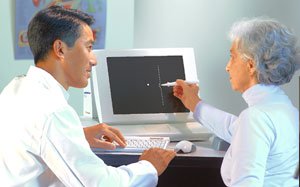New screening device promotes early detection of AMD
The goal is to target patients before the disease is so far advanced that achieving good visual outcomes becomes unrealistic, one specialist said.
WAILEA, Hawaii — A new diagnostic tool could help in the early detection of choroidal neovascularization and intermediate age-related macular degeneration, according to a retina specialist.
The device, called the PreView PHP (for preferential hyperacuity perimeter) from Carl Zeiss Meditec, will hopefully help detect AMD early in its course. The aim is to target AMD patients before their vision is severely impaired and while emerging therapies are at their most beneficial, Andrew P. Schachat, MD, said in his presentation here at Retina 2006, held in conjunction with Hawaiian Eye 2006.
“Without good detection you cannot maximize the benefits of new therapies,” Dr. Schachat said. “At the time of diagnosis, 40% [of AMD patients] are already legally blind and 80% have subfoveal lesions.”
Treatments such as Visudyne (verteporfin by injection, QLT/Novartis), Macugen (pegaptanib sodium injection, Pfizer/OSI Pharmaceuticals) and Lucentis (ranibizumab, Genentech/Novartis) are more effective when the disease is caught early, he noted.
Dr. Schachat said current screening and management strategies leave much to be desired.
“We know that lesion size is an important factor for predicting post-treatment outcome,” he said. “Smaller is better, earlier is better.”
He said patients with AMD must be caught at a much earlier stage “when lesions are small and when they have better baseline vision.”
Multi-center study
The PreView PHP demonstrated high sensitivity and specificity in a multi-center study including 122 patients, said Dr. Schachat, one of the clinical investigators in the study. Sensitivity and specificity were the primary outcomes of the study.
The sensitivity of the device was found to be 82%, and the specificity 88%. These results were compared to the diagnoses of retina specialists who evaluated each patient in the trial, he said.
PHP sensitivity refers to the probability that the test result is positive, given that the patient has the disease, Dr. Schachat explained. Specificity is the probability that the result is negative, given that the patient does not have the disease.
People were included based on their mental and physical capability to take the test and their willingness to sign informed consent forms. They were excluded if they had other macular conditions.
How the test works
The test, which is performed in the doctor’s office, takes approximately 5 to 10 minutes per eye to administer. The patient sits at a computer screen, where a total of 500 data points are tested three to five times each.
The device is able to overcome the brain’s ability to compensate for small visual field defects that are consistent with intermediate dry AMD. Therefore, it can identify small lesions at their inception.
“Whenever patients see a blip in the line, they press a button, and the machine keeps track of when you seen the blips,” Dr. Schachat said.
The data, which counts false positives, is compared to normative data, he added. The physician must decide how sensitive the test should be, in order to avoid false positives.
|
Image: Schachat AP |
Potential utility
Dr. Schachat said the perimeter could be particularly useful in the primary eye care setting to identify people at risk and refer them earlier to a retinal specialist. He and his fellow investigators predict that with the use of PreView PHP, eight out of 10 patients with intermediate AMD or CNV will be diagnosed earlier than they are today.
At this point, it is too soon to say with certainty if patients in the study will have better visual outcomes, Dr. Schachat told Ocular Surgery News via e-mail. An interesting future study would be one comparing patients who receive treatment earlier because of the PreView PHP to those treated at a more advanced stage.
Dr. Schachat noted that there is a chance the device could be used for other applications as well.
“Presumably, [the PreView PHP] can detect CNV due to other reasons than AMD, but this has not been studied,” he said.
The PreView PHP is available in Europe and the United States.
For Your Information:
- Andrew P. Schachat, MD, can be reached at Johns Hopkins Hospital, 600 N. Wolfe, Maumenee 713, Baltimore, MD 21287-9275; 410- 955-7411; fax: 410-614-1683; e-mail: aschachat@jhmi.edu.
- Lauren Wolkoff is Managing Editor of OSN Latin America and Japan Editions.

